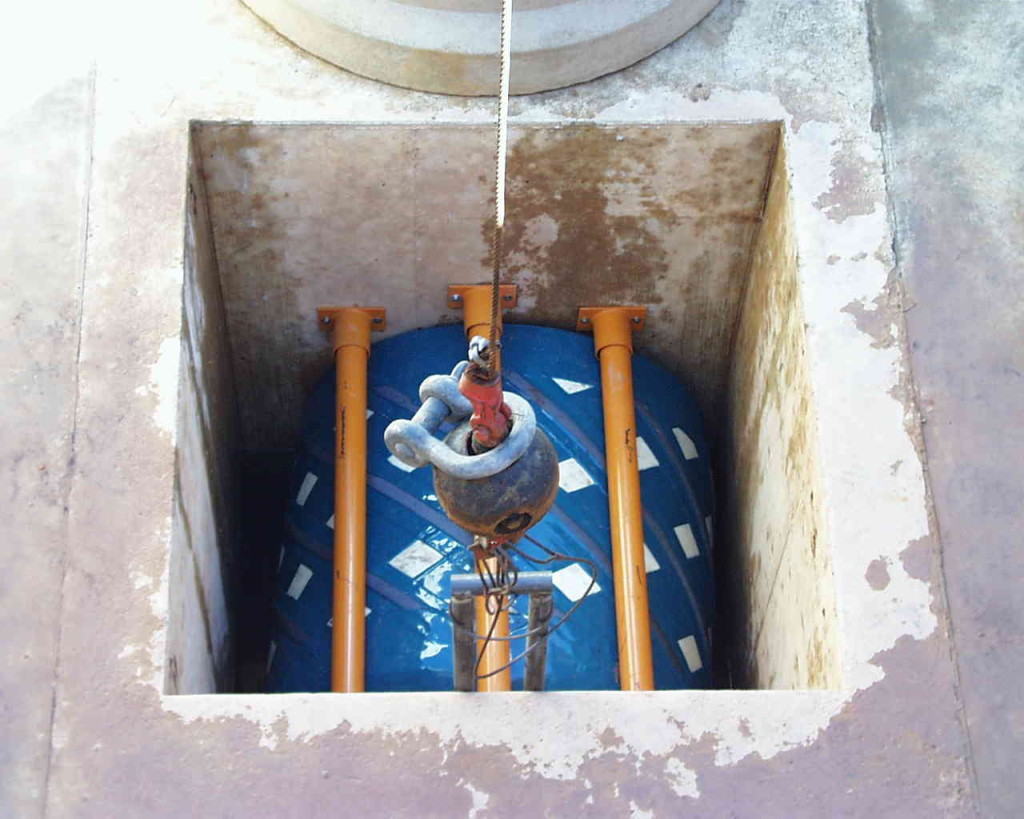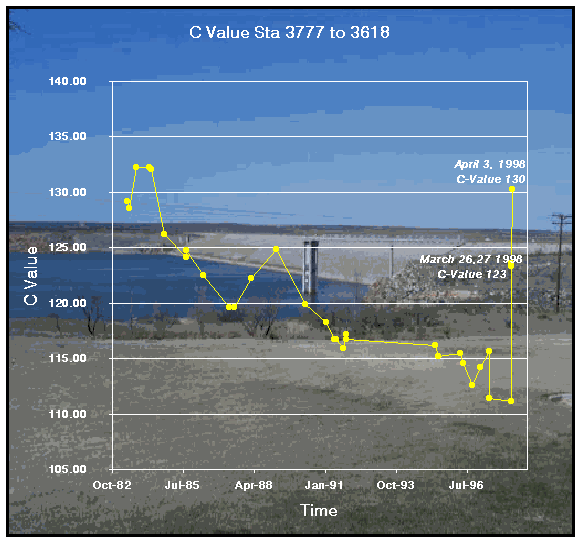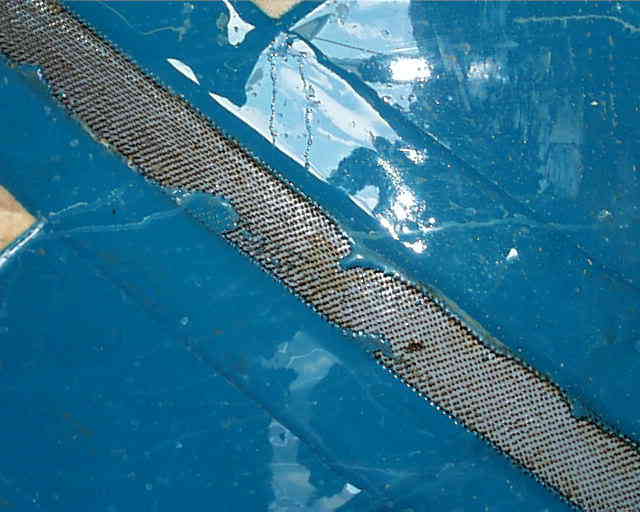Pigging refers to the practice of using pipeline inspection gauges or “pigs” to clean the inner walls of a pipe while it is still in operation. Pigs get their name from the squealing sound they make while traveling through the pipeline.
Overview
The flow capacity of the central system has been declining for the past 15 years due to a build-up of calcium carbonate (CaCO2) on the inner wall of the pipe. Because of the increased friction, water levels in the pipe stands and the vent structures rise and overflow at high flows. The sections of the central system that have experienced the most problems are from the first pipe stand (Sta 2976+02.5) to pipe stand (Sta4049+96.88).
CRMWA’s aim has been to increase the flow in the central system back to its original capacity or as close to it as possible. In 1994, CRMWA began working in conjunction with Texas Tech University on a project to remove the buildup of CaCO2 by injecting carbon dioxide directly into the central system. This experimental project was unsuccessful in removing a significant amount of the buildup inside the pipe.
Planning for efforts to try to pig the central system began in early 1997. The purpose of this project was to determine if the pigging would be effective in cleaning the pipe, therefore, only one or two sections were budgeted to be pigged. If the pigging project was successful, then other sections would be pigged at a later time.
Design & Planning
Choosing a Test Section
The first objective was to determine which section or sections of the central system would serve as the best trial run for the pigging. Since the project was experimental in determining if the pigging would be effective or not, the aim was to find a section that would be the simplest and the least expensive.
The most important feature of the system, when considering what section to pig, proved to be the size of the outlet sump. Some of the pipe stands have outlet sumps which are not as wide as the diameter of the pipe. Since this would make launching more difficult and possibly require a different kind of pig, these sections were not considered for this initial project, though there are ongoing discussions with pig manufactures to ensure that pigs can be made to accommodate these sections.
One section (Pipe Stand 3374 + 98.7 to Pipe Stand 3617 + 00.67) has a decrease in pipe diameter from 72 inches to 66 inches, which caused some concern because of the additional uncertainties of a reduction in the pipe diameter. This section was not chosen for this reason, especially since this was an experimental project. Other sections were not chosen for similar reasons. The section that appeared to present the least amount of problems or unknowns was the 66-inch between Pipe Stands 3617 and 3776+97.93 just east of Happy, Texas. The outlet sump was large enough to allow the pig to be lowered and positioned up to the pipe opening.
Pig Design
There are many different kinds of pigs with different shapes and materials of construction that serve a variety of pipe cleaning functions. Initially, a swab pig (a foam pig without a polyurethane coating) was recommended to act as a test pig since it is very flexible and not likely to become lodged in the pipe. The use of a swab pig was later abandoned since these pigs usually only help in determining if valves are open in a complex pipe system and which route the pig will take. These were not unknowns in our case and it was decided to use only the cleaner pig.
The most important function for the cleaner pig (foam pig with polyurethane coating and abrasive straps) was to remove the CaCO2 all together or smooth the buildup enough to provide increased capacity. The recommendation from several pig manufacturers was to use wire brush straps around the pig to act as the primary cleaning/scrubbing agent. Samples of the wire brush straps were hand applied to the inner wall of the pipe during an inspection in January 1998. The wire brush seemed to be somewhat effective after several passes. Spencer Cubbage of Flowmore Services, Inc. was present to assess the pipe and the project. His recommendation was to use wire brushes and to run the pig at slow rate (approximately 1.5 to 2.0 ft/sec). He also recommended the diameter of the pig be equal to that of the pipe. Jim Gammill of Girard Industries, Inc. recommended higher flow rates (3.0 to 5.0 ft/sec) and a pig diameter of 1 inch greater than the pipe. Since Girard Industries, Inc. submitted the low bid and was awarded the contract, their recommendation was followed.
Launching the Pig
There were several potential problems when it came to launching the pig. The biggest problem was the fact that the pig would float and possibly have an upward buoyant force of 8,000 lbs. when submerged in water. If the pig could not be forced completely into the pipe, then something would have to hold the pig down as the water level rose. It was questionable that the pig could be forced into the pipe because of it being oversized. Also, water had to get by the pig to fill the partially drained line so that surging could be minimized. Several ideas were considered, but the simplest solution was to bolt steel pipe beams inside the sump over the top of the pig to hold it down as the pipe stand was being filled. Two pieces of pipe were welded together (in the shape of a fork) and put in front of the pig to prevent it from launching while the pipe was being filled. Figure 1 below is a photo of the pig being held in place with the pipe beams. Once the pipe was filled, the steel pipe would be removed and the pig could be launched.

Figure 1 – Pig in Sump of Pipe Stand
Pig Retrieval
Two major concerns with retrieving the pig were its weight (it could weigh 6,000 lbs. wet) and the possibility of it becoming lodged in the next outlet sump/pipe entrance and blocking flow (thus requiring the flow to be turned off for retrieval). Because of the anticipated high concentration of suspended solids, it was decided that the flow should remain high for at least 48 hours in order to keep the solids in suspension until the water reached the Lubbock reservoir. Jim Gammill of Girard stated that the pig would not absorb so much water that it would loose its buoyancy and that it would float when it fell out of the pipe stand. Straps could then be lowered around the pig for removal by the crane.
1st Pig Run
Launching/Retrieving
The first pig run went as anticipated except that the buoyant force on the pipe beams was so great that the pig could not launch. The pipe had to be drained enough so that the pig could be forced up to the pipe opening allowing little water to pass. This proved to be sufficient as the pig launched with approximately 10 to 15 feet of head.
With the use of the pig tracker, the pig was monitored to determine an approximate arrival time and also to locate the pig in case it became lodged. The pig averaged between 2.7 and 3.0 feet per second, roughly 85-90% of the velocity of the water. Approximately 10 minutes before the pig arrived at Pipe Stand 3776+97.93, the water increasingly became more turbid and eventually a brownish color. Also, several minutes ahead of the pig, a thumping in the ground could be felt.
The pig came out of the riser pipe and fell over on top of the water just as expected. Members of the crew lowered lifting straps around the pig for easy removal of the pig by the crane.
C-Values
After the first run, water levels in the vent structures were measured to determine if there was any noticeable change in the C-value. The most recent measurements indicated that the C-value was approximately 111 before pigging. Immediately afterwards, measurements indicated that the C-value had risen to 123 (an 11% increase). Measurements taken the next day (March 27) also produced a C-value of 123. Figure 2 shows C-values for the last 16 years for this section up the second pig run.

Figure 2 – C Values
Pig Inspection
The day following the first run the pig was inspected for damage and wear. Surprisingly, a majority of the pig didn’t seem to have rubbed or touched the pipe wall, as there was little wear on the polyurethane coating or the wire brushes as can be seen in Figure 3. The fact that the C-value had increased substantially and yet the pig showed limited wear was somewhat puzzling. It was decided to run the pig a second time to see if additional benefits could be accomplished.

Figure 3 – Pig Inspection After Being Run
Pipe Inspection
When the line was drained in preparation for the second pig run, the first 100-ft. of the pipe was inspected to see what effect the pig had on the CaCO2 buildup. Surprisingly, there was little evidence that the pig had smoothed the inner wall of the pipe much less remove any buildup. The evidence didn’t seem to be consistent with the increased C-value, as previously discussed.
Figure 3 – Pig Inspection After Being Run
Launching/Retrieving
Because of the problems with launching the first time, the pipe fork used to prevent the pig from launching prematurely was not put in front of the pig as the pipe was being filled with water. However, before the water rose high enough to force the pig up against the pipe beams, the pig was pulled up to the pipe opening by the flowing water. A few minutes later, the pig launched with little head and with the pipe not completely filled.
Because of the concern of surging, the flow was left at a low rate (6-10 cfs) to allow time for water to bypass the pig and fill the line ahead. This put the pig moving at less than .5 fps. The progress of the pig was monitored by watching the clarity of the water at the air valves. After all or most of the air was removed from the line, the flow was increased to 50 cfs and then 80 cfs for the last hour of the run.
There was some difficulty in retrieving the pig partly because of 40-mph winds and light weight lifting straps that floated in the water.
C-Values
Once again, the C-value increased, however, not as much as after the first run. The C-values increased from approximately 123 to 130 as shown in Figure 2. Since a C-value of 130 is close to that of new concrete pipe, it was decided to monitor this section and save the pig for possible future runs. The pig project raised the C-value a total of 17%.
Water Analysis
Prior to the pig arrival on the second run, a water sample was taken so that tests could be performed to determine the content of the suspended solids. The results indicate that a high percentage (up to 95 %) of the suspended solids is calcium carbonate. The sample was tested for organic materials but no significant amount was found.
Current Pigging?
The central system (Pipe Stand 3044+16 to Pipe Stand 5107+02) is currently being pigged on an annual basis when other maintenance issues don’t interfere.